

Winston Churchill Biography. As prime minister, Sir Winston Churchill rallied the British people during WWII, and led his country from the brink of defeat to victory.
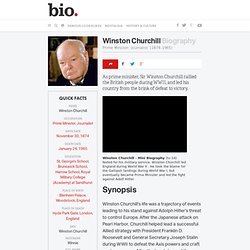
Synopsis Winston Churchill's life was a trajectory of events leading to his stand against Adolph Hitler's threat to control Europe. After the Japanese attack on Pearl Harbor, Churchill helped lead a successful Allied strategy with President Franklin D. Winston S. Churchill - British History. “I have nothing to offer but blood, toil, tears and sweat,” Churchill told the House of Commons in his first speech as prime minister.
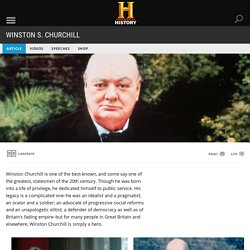
“We have before us many, many long months of struggle and of suffering. You ask, what is our policy? I can say: It is to wage war, by sea, land and air, with all our might and with all the strength that God can give us; to wage war against a monstrous tyranny, never surpassed in the dark, lamentable catalogue of human crime. That is our policy. You ask, what is our aim? Winston S. Churchill - British History. Winston Churchill. The Right Honourable Sir Winston Leonard Spencer Churchill (1874-1965), the son of Lord Randolph Churchill and his American wife Jennie Jerome, was educated at Harrow and Sandhurst.

After a brief but eventful career in the army, he became a Conservative Member of Parliament in 1900. Sir Winston Churchill - Biography. Who Was Winston Churchill?

Winston Churchill was a legendary orator, a prolific writer, an earnest artist, and a long-term British statesman. Yet Churchill, who twice served the as the Prime Minister of the United Kingdom, is best remembered as the tenacious and forthright war leader that led his country against the seemingly undefeatable Nazis during World War II. Dates: November 30, 1874 -- January 24, 1965 Also Known As: Sir Winston Leonard Spencer Churchill. The Official Churchill Biography. About The Official Biography WINSTON S.

CHURCHILLby Randolph Churchill & Martin Gilbert Churchill had long wished to write his father's biography, and by the end of the 1950's was making strong efforts to win his father's confidence. In May 1960 Winston Churchill wrote to his son: "My dear Randolph, I have reflected carefully on what you said. I think that your biography of Derby [Lord Derby, by Randolph Churchill, Cassell: London 1959] is a remarkable work, and I should be happy that you should write my official biography when the time comes. Biography Introduction. Mini BIO - Winston Churchill. Sir Winston Churchill Biography: British Prime Minister's Life. Winston Churchill Biography. Adolf Hitler Video - Winston S. Churchill. Adolf Hitler Video - Winston S. Churchill. La fin mystérieuse d'Adolf Hitler. Les Complices D'hitler. L'Apocalypse par Hitler: La menace .avi. Adolf Hitler. Adolf Hitler [ˈadɔlf ˈhɪtlɐ][a] Écouter est un idéologue et homme d'État allemand, né le 20 avril 1889 à Braunau am Inn en Autriche-Hongrie (aujourd'hui en Autriche et toujours ville-frontière avec l’Allemagne) et mort par suicide le 30 avril 1945 à Berlin.
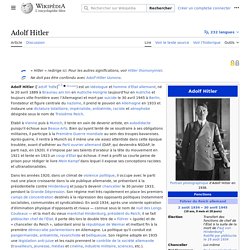
Fondateur et figure centrale du nazisme, il prend le pouvoir en Allemagne en 1933 et instaure une dictature totalitaire, impérialiste, antisémite, raciste et xénophobe désignée sous le nom de Troisième Reich. Membre du Parti national-socialiste des travailleurs allemands (NSDAP, le parti nazi), créé en 1920, il s'impose à la tête du mouvement en 1921 et tente en 1923 un coup d'État qui échoue. Il met à profit sa courte peine de prison pour rédiger le livre Mein Kampf dans lequel il expose ses conceptions racistes et ultranationalistes. Dans les années 1920, dans un climat de violence politique, il occupe une place croissante dans la vie publique allemande jusqu'à devenir chancelier le 30 janvier 1933, pendant la Grande Dépression. La prise de pouvoir de Hilter .... Mein Kampf - c'était écrit.avi. Germany joins the League of Nations 1926. In 1924, the newly appointed foreign minister of Germany, Gustav Stresemann, adopted a new policy toward the League of Nations, which governments in Berlin previously had spurned as an instrument created by the victors of World War I to suppress the defeated Germans.
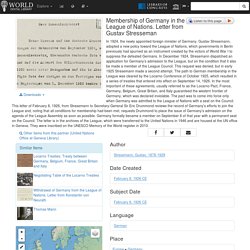
In December 1924, Stresemann dispatched an application for Germany’s admission to the League, but on the condition that it also be made a member of the League Council. This request was denied, but in early 1925 Stresemann made a second attempt. The path to German membership in the League was cleared by the Locarno Conference of October 1925, which resulted in a series of treaties that entered into effect on September 14, 1926. In the most important of these agreements, usually referred to as the Locarno Pact, France, Germany, Belgium, Great Britain, and Italy guaranteed the western frontier of Germany, which was declared inviolable. Homework: Did the position of women improve in the Weimar Republic. Art, architecture and cinema: Weimar Culture. 1.1 The War Ends.
1.1 The Weimar Republic. 1.2 Challenges to the Weimar Republic. 1.2 Unpopularity of Weimar Republic 1919 1923. 1.3 Recovery under Stresemann. 1.4 Life Imrpoves in the Weimar Republic. Kaiser Wilhelm II - SIMPLE. Apocalypse - The Second World War - Episode 6 - Inferno 1944 - 1945. Apocalypse The Second World War Ep 5 6 The Great Landings The Noose 1942 1943. Apocalypse The Second World War Ep 4 6 World Ablaze 1941 1942. Apocalypse The Second World War Ep 3 6 Shock 1940 1941. Apocalypse: The Second World War - 1/6 - Aggression (1933. World War II in Europe Timeline. Jump to: 1939 - 1940 - 1941 - 1942 - 1943 - 1944 - 1945 1918 November 11 - World War I ends with German defeat. 1919 April 28 - League of Nations founded.
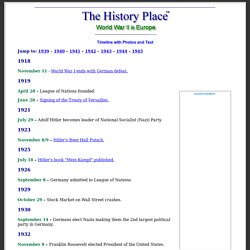
June 28 - Signing of the Treaty of Versailles. 1921 July 29 - Adolf Hitler becomes leader of National Socialist (Nazi) Party. 1923 November 8/9 - Hitler's Beer Hall Putsch. 1925 July 18 - Hitler's book "Mein Kampf" published. 1926 September 8 - Germany admitted to League of Nations. 1929 October 29 - Stock Market on Wall Street crashes. 1930 September 14 - Germans elect Nazis making them the 2nd largest political party in Germany. 1932 November 8 - Franklin Roosevelt elected President of the United States. 1933 January 30 - Adolf Hitler becomes Chancellor of Germany. February 27 - The German Reichstag burns. March 12 - First concentration camp opened at Oranienburg outside Berlin. March 23 - Enabling Act gives Hitler dictatorial power.
Bombing of Tokyo. Bombing of Tokyo (東京大空襲, Tōkyōdaikūshū?)
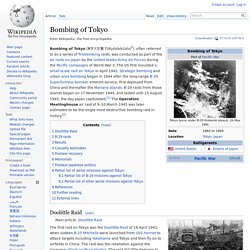
, often referred to as a series of firebombing raids, was conducted as part of the air raids on Japan by the United States Army Air Forces during the Pacific campaigns of World War II. The US first mounted a small-scale raid on Tokyo in April 1942. Strategic bombing and urban area bombing began in 1944 after the long-range B-29 Superfortress bomber entered service, first deployed from China and thereafter the Mariana Islands.
B-29 raids from those islands began on 17 November 1944, and lasted until 15 August 1945, the day Japan capitulated.[1] The Operation Meetinghouse air raid of 9–10 March 1945 was later estimated to be the single most destructive bombing raid in history.[2] §Doolittle Raid[edit] World War II. Dunkirk. Dunkirk, and the evacuation associated with the troops trapped on Dunkirk, was called a "miracle" by Winston Churchill.

As the Wehrmacht swept through western Europe in the spring of 1940, using Blitzkrieg, both the French and British armies could not stop the onslaught. For the people in western Europe, World War Two was about to start for real. The Rise of Adolf Hitler (Biography) From Unknown to Dictator of Germany 24 Chapters [ The History Place Main Page | American Revolution | Abraham Lincoln | U.S. Civil War | Child Labor in America 1908-1912 | U.S. in World War II in the Pacific | John F. Kennedy Photo History | Irish Potato Famine | Genocide in the 20th Century | World War I Timeline | Photo of the Week | Speech of the Week | This Month in History | Books on Hitler's Germany | History Videos | Movie Reviews | Advertise | Send Feedback ] Copyright © 1996 The History Place™ All Rights Reserved. Mein Kampf (English Translation)
Adolf Hitler. Adolf Hitler was born on 20th April, 1889, in the small Austrian town of Braunau near the German border. Both Hitler's parents had come from poor peasant families. His father Alois Hitler, the illegitimate son of a housemaid, was an intelligent and ambitious man and was at the time of Hitler's birth, a senior customs official in Lower Austria.
Alois had been married before. Hitler Youth Materials. Kurt Gruber formed the first group of young members of the National Socialist German Workers Party (NSDAP) in 1926. Rudolf Hess suggested the name of the Hitler Youth (Hitlerjugend) and later that year transferred the leadership of the movement to Franz von Pfeffer of the Sturm Abteilung (SA). Pfeffer's main intention was to train young men to fight against members of left-wing youth groups. The Hitler Youth (HJ) were taken over by Ernst Roehm in 1930 and remained as a adjunct to the SA.
After Roehm was murdered during the Night of the Long Knives the group came under the control of Baldur von Schirach, the Reich youth leader. In this post he had proved himself to be a master organizer. Schirach asked Adolf Hitler for permission to create an independent youth movement. Nazi Propaganda (1933-1945) The SS Black Book. The Black Book was the post-war name given to the Sonderfahndungsliste G.B. ('Special Search List G.B'), the list of prominent Britons to be arrested in the case of a successful invasion of Britain by Nazi Germany in World War II. The list was a product of the SS Einsatzgruppen and compiled by Walter Schellenberg. It contained the names of 2,820 people, British subjects and European exiles, living in Britain who were to be immediately arrested if Unternehmen Seelöwe, the invasion of Britain, succeeded. The list was appended to the 'Informationsheft GB', a 144 page handbook containing information on important aspects of British society including institutions such as embassies, universities, newspaper offices, and Freemasons' Lodges.
Sounds and Pictures Catalogue. World War II. History: World War Two. The most brutal battle in history. Germans fighting for every inch of the road to Stalingrad, 1942 [] Four-and-a-half-million men deploying 600,000 vehicles, 3,700 tanks, 750,000 horses, 1,800 bombers and fighters and half a million guns streamed eastwards on a 1,800-mile-long front at 3.15am on the morning of June 22, 1941. They were the bearers of a New World Order whose cruelty would beggar belief. This was the start of Operation Barbarossa, Hitler’s assault on the Soviet Union intended to wipe out communism, the Jewish race, and to give Germans the “living space” upon the vast Russian steppes that the Führer had promised his people in Mein Kampf. By the time the battle for the Eastern front was over at the end of 1944 an estimated seven million Russian soldiers had died in combat while a staggering 20 million civilians were murdered, killed in the fighting or in captivity, or starved to death.
More than four million German troops died. And yet it was the Russians who ultimately won. Battle of Stalingrad - World War II. The Russians hailed it a “contemporary Cannae,” and the Germans condemned it as a Rattenkrieg (Rat War). Both descriptions were fitting. In the Battle of Stalingrad, Soviet forces surrounded and crushed an entire German army under General Friedrich Paulus, emulating Hannibal’s encirclement and destruction of a Roman army under Aemilius Paulus in 216 B.C. For both sides, Stalingrad became a desperate ordeal of rodentlike scurrying from hole to hole.
The Battle of Stalingrad. WINSTON CHURCHILL. THE BATTLE OF BRITAIN. Second World War. History - World War Two: Summary Outline of Key Events. Primary History - World War 2. Second World War 1939 - 1945. Yt Hitler's Britain [an alternate history] 10/10. Clever Camouflage. Spies uncovered in Horrible Histories exhibition. Imperial War Museum Horrible Histories Spies exhibition: Amazing gadgets of WWII heroes from rat bombs to pipe pistols.
History - World Wars: British Special Operations Executive (SOE): Tools and Gadgets Gallery. History - Code breaking (pictures, video, facts & news) History - World Wars: The Special Operations Executive 1940 - 1946. History - World Wars: Double Cross - MI5 in World War Two. What was the role of Special Operations Executive and what kind of people worked for it? History - World Wars: Training SOE Saboteurs in World War Two. History - World Wars: Breaking Germany's Enigma Code. 10th August 1941: Food rationing concentrates the mind in Britain. The wartime allowance for one person for one week, the main restrictions were on meat, dairy products and sugar and confectionary. Other items might not be rationed but were in short supply and difficult to get. Archive - WWII: The Battle of Britain - Memories of 'Britain's finest hour' The Battle of Britain. Why did Britain win the Battle of Britain in 1940?
The London Blitz, 1940. The London Blitz, 1940. The London Blitz, 1940. 1914 : LES ÉTINCELLES DE LA GUERRE. Les soldats et régiments dans le conflit 1914-1918. Un très grand nombre de sites et de blogs existent sur les soldats et les régiments de la Grande Guerre. Ils sont le plus souvent le fruit de recherches généalogiques et d'un travail de mémoire menés par les auteurs. Appuyés sur une connaissance pointue de l'histoire militaire du conflit, ils peuvent être utilisés par les historiens au cours de leurs recherches.
Stats From History sur Twitter : "11% of France's entire population was killed/wounded during #ww1... D comme Décorations. Alors qu'Albert Daulier disparaissait au Bois-le-Prêtre, un autre AAGP de Suzane, à peine âgé de 19 ans, passait au 24e régiment d'infanterie. Quels sont les faits de guerre d'Henri Launey ? Henri Launey a fait la campagne contre l’Allemagne du 18 décembre 1914 au 12 septembre 1919 et a survécu à l'hécatombe. Est-ce le fait qu'il ne soit pas mort au combat... mais je me suis beaucoup moins intéressée à son sort jusqu'à présent ? Et pourtant, il y a beaucoup à dire. Le parcours du combattant de la guerre 1914-1918. Sources de la Grande Guerre.
La Grande Guerre 1914-1918 - Annuaire de sites Internet sur la Première Guerre Mondiale et ressources multimédias. Exposition virtuelle - Sur les chemins de la Grande Guerre. Bienvenue sur le mémorial des poilus de l'Isère. Histoire 1ére Guerre Mondiale 14-18. Mémorial 14-18.net. Représenter et se représenter la Première Guerre mondiale - Faire parler les images (1914-1918) Si les photographies pouvaient parler... (2) A l'heure du repas, après fin 1916, 90e RI(1) : Il arrive qu'un détail attire notre attention et que, de fil en aiguille, une image dévoile une partie inhabituelle de la vie militaire de l'époque. Ou au contraire, si habituelle qu'elle en est même classique et que l'on n'y prête plus attention... Pause au 90e RI : Ressources Internet. Et pourquoi le poilu ?
La Première Guerre mondiale : Cartes animées, bataille de la Marne, Ypres, Verdun, la Somme, Caporetto. Spécial 14-18 : Le déclenchement d'un conflit hors-norme. Exposition : 1915-1919, Un hôpital militaire canadien à Saint-Cloud - hopitauxmilitairesguerre1418.overblog.com. Kaiser Wilhelm II - World War I. Kaiser Wilhelm II: His life and facts. Kaiser Wilhelm II. Wilhelm II. Kaiser Wilhelm - Emperor. A simple overview. Timeline of World War One.